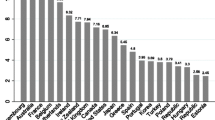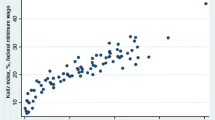Abstract
This paper analyzes the impact of collective minimum wages on youth employment for 14 sectors of the Austrian economy, taking into account the possibility of nonlinearity. We find that when the real index of minimum wage rises above a certain point, negative employment effects for young individuals (aged between 19 and 25 years) can be expected in Austria. In five of seven market sectors the minimum wage lies above the optimal level that maximizes the employment of young workers.





Similar content being viewed by others
Notes
For a detailed study of the coverage in Austria, see Bönisch (2008).
Nomenclature statistique des activités économiques dans la Communauté Européenne
We have tested an additional specification in which we seasonally adjust tha data with the two-sided Hodrick-Prescott filter, which produces a slightly smoother curve. The results remain unchanged.
We have tested the specifications also for the age group 15 to 24. Results for this age group turned out to be quite similar to those presented in this paper.
The employment rate is defined as the employment of the 19 to 25 year olds as the fraction of the labor force in this age group.
For the mining and quarrying sector, there are less then ten minimum wages included in the TLI index. Therefore only those are used to calculate the minimum wage.
Only the main specification is reported; other results are available from the authors upon request.
Only the main specification is reported; other results are available from the authors upon request.
References
Arellano M, Bond S (1991) Some tests of specification for panel data: Monte carlo evidence and an application to employment equations. Rev Econ Stud 58(2):277–297
Baker M, Benjamin D, Stanger S (1999) The highs and lows of the minimum wage effect: a time-series cross-section study of the Canadian law. J Labor Econ 17(2):318–350
Bechter B (2009) Determinanten der Entlohnung. PhD thesis, Universität Wien
Bönisch M (2008) Kollektivvertragliche abdeckung in Österreich. Statistische Nachrichten 3(2008):207–211
Brown AJ, Merkl C, Snower DJ (2014) The minimum wage from a two-sided perspective. Econ Lett 124(3):389–391
Card D, Krueger A (1994) Minimum wages and employment: a case study of the fast-food industry in New Jersey and Pennsylvania. Am Econ Rev 84(4):772–793
Cardoso AR, Portugal P (2005) Contractual wages and the wage cushion under different bargaining settings. J Labor Econ 23(4):875–902
Christl M, Köppl-Turyna M, Kucsera D (2015) Employment effects of minimum wages in Europe revisited. Working paper
Dolton P, Bondibene CR (2011) An evaluation of the international experience of minimum wages in an economic downturn. Report prepared for the Low Pay Commission, March
Gürtzgen N (2009) Rent-sharing and collective bargaining coverage: Evidence from linked employer-employee data. Scand J Econ 111(2):323–349
Neumark D, Wascher W (2004) Minimum wages, labor market institutions, and youth employment: a cross-national analysis. Ind Labor Relat Rev 57(2):223–248
Neumark D, Wascher W (2006) Minimum wages and employment: a review of evidence from the new minimum wage research. Tech. rep., National Bureau of Economic Research
OECD (1998) Making the most of the minimum: Statutory minimum wages, employment and poverty. Employment Outlook, Chapter 2
OECD (2012) Labour losing to capital: What explains the declining labour share? OECD Employment Outlook 2012
Ragacs C (1993a) Employment, productivity, output and minimum wages in Austria: A time series analysis. Vienna University of Economics and BA, Department of Economics Working Paper Series 21
Ragacs C (1993b) Minimum wages in Austria: Estimation of employment functions. Vienna University of Economics and BA, Department of Economics Working Paper Series 20
Ragacs C (2003) Mindestlöhne und Beschäftigung. Ein Überblick über die neuere empirische Literatur
Statistik Austria (2011) Standard-Dokumentation Metainformationen (Definitionen. Erläuterungen, Methoden, Qualität) zum Tariflohnindex 06
Author information
Authors and Affiliations
Corresponding author
Appendix
Appendix
See Tables 9, 10, 11, 12, 13, 14, 15, 16, 17, 18, 19, 20, 21.
Rights and permissions
About this article
Cite this article
Christl, M., Köppl-Turyna, M. & Kucsera, D. Effects of collective minimum wages on youth employment in Austria. Empirica 44, 781–805 (2017). https://doi.org/10.1007/s10663-016-9341-7
Published:
Issue Date:
DOI: https://doi.org/10.1007/s10663-016-9341-7




